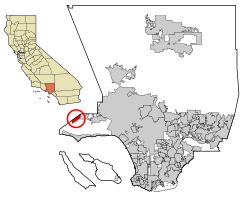Westlake Village
| Westlake Village, California | |
|---|---|
| City | |
| City of Westlake Village | |

Aerial view of the Westlake Village subdivision
|
|
 Location of Westlake Village in Los Angeles and Ventura counties, California |
|
| Location in the United States | |
| Coordinates: 34°8′31″N 118°49′10″W / 34.14194°N 118.81944°WCoordinates: 34°8′31″N 118°49′10″W / 34.14194°N 118.81944°W | |
| Country | |
| State |
|
| County | Los Angeles and Ventura |
| Incorporated (city) | December 11, 1981 |
| Government | |
| • Mayor | Brad Halpern |
| Area | |
| • Total | 5.509 sq mi (14.257 km2) |
| • Land | 5.185 sq mi (13.430 km2) |
| • Water | 0.320 sq mi (0.828 km2) 5.80% |
| Elevation | 880 ft (268 m) |
| Population (2010) | |
| • Total | 8,270 |
| • Density | 1,500/sq mi (580/km2) |
| Time zone | PST (UTC-8) |
| • Summer (DST) | PDT (UTC-7) |
| ZIP Code | 91359, 91361, 91362 |
| Area code | 747/818 (Los Angeles County portion), 805 (Ventura County portion) |
| FIPS code | 06-84438 |
| Website | www |
Westlake Village is a planned community that straddles the Los Angeles and Ventura county line. The eastern portion is the incorporated city of Westlake Village, located on the western edge of Los Angeles County, California. The city, located in the region known as the Conejo Valley, encompasses half of the area surrounding Westlake Lake, and small neighborhoods primarily south of U.S. Route 101 and east of La Venta Drive. The population was estimated to be at 8,473 in 2014, up from 8,368 at the 2000 census. The headquarters of the Dole Food Company is also located in Westlake Village.
The western portion of Westlake Village is a community, within the city limits of Thousand Oaks, in Ventura County. The properties and businesses in this portion can be addressed as "Westlake Village", as the United States Post Office maps both 91361 and 91362 ZIP codes to this area. Built across the county line as a planned development, residents recognize that the community of Westlake Village is not limited to the incorporated city in Los Angeles County, but encompassing the entire area surrounding the man made lake.
The original community was known simply as "Westlake". Roughly two-thirds of it was annexed by the city of Thousand Oaks in two portions, in 1968 and 1972. In 1981, the remaining third eventually incorporated as the City of Westlake Village.
About 3,000 years ago, Chumash Indians moved into the region and lived by hunting rabbits and other game, and gathering grains and acorns. On-going excavations, archaeological sites, and polychrome rock paintings in the area provide a glimpse into the social and economic complexity of the ancient Chumash world.
In January, 1770, the first Europeans came to the area. Captain Gaspar de Portolà's party of Spanish explorers and missionaries traveled through the area from west to east, camping one night near a Chumash village, believed to be the site of present-day Westlake Village. Father Juan Crespí, chaplain and diarist of the expedition, wrote: "We are on a plain of considerable extent and much beauty, forested on all parts by live oaks and oak trees, with much pasturage and water." Crespi named the place El triunfo del Dulcísimo Nombre de Jesús (in English: The Triumph of the Sweetest Name of Jesus) to a camping place by a creek – today's Triunfo Canyon Road begins between Thousand Oaks and Westlake Village (see Conejo Valley). Later Spanish travelers also used this route, making it part of El Camino Real (today's U.S. Route 101).
...
Wikipedia

